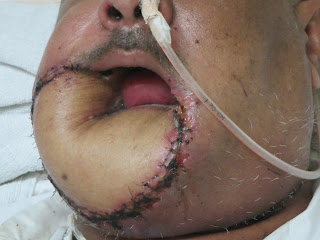~ ~ ~ ~ ~ ~ ~ ~ ~ ~ ~ ~
Walking through the hospital each day, I have been practicing my Hindi, trying to read the characters, and counting to 100. I slowly sound out the characters and my resident helps correct me :) She has been teaching me more and more phrases each day and, in exchange, I help teach her a little spanish. Haha I feel like a little kid again. Sometimes when I try speaking Hindi to new people I meet, they just start jabbering away quickly. I just smile and nod, but remind them, "Mein Hindi seek ruhihun." (I'm learning Hindi) "Mujhey maloom thoda, thoda" (I know a little, little- as I pinch my fingers demonstrated the tininess of my knowledge...). With the patients and on the floors everyone speaks Hindi. Up in the ORs, people tend to speak English/Hindi mixed together. Sometimes they switch from one to the other and it confuses me. I can hear the Brittish influence in many of their accents (especially the attendings who have trained in the UK). Everyone calls the attendings "sir", the nurses are called "sister.", and I am called "ma'am." It's amazing how polite everyone is. (I asked what they call male nurses and they said they don't know... but perhaps "brother"). The operation rooms (ORs) are called Operation Theatres (OTs). They have tea and biscuit breaks in between rounds and cases- which I love!
Our first case of the day was a cleft lip repair of a little 6 month old baby. It made me think of one of my best friends, MK, and her baby, Jude. (well he's a little man now- 8 years old!). He is definitely one of my favorite little people. I remember being able to hold him at the hospital where he was born, kissing his tiny forehead, and then watching him grow up. He was born with a cleft lip and palate and I have seen his transition through each of his surgeries. Being in this surgery today made me think of Mk and Jude and the impact that these operations can have. Today I watched as the tiny incisions allowed the skin to fold together and close the gap of this little baby's mouth. My attending explained every step as he created the rotation-advancment flap (the Millard Flap Technique). In college I spent many hours in the ceramics studio carefully molding the clay to create my pieces. The human body is a surgeon's art piece. I love those delicate incisions, carefully placed sutures, and watching such little faces transform in front of my eyes.
We also have several patients with buccal mucosal cancer (from the popular paan and other chewing tobaccos). Flaps are used from the thigh, wrist, or shoulder to fill in the gap where the cancer was resected. For the patient below, an anterolateral thigh (ATL) flap was used to fill in this defect, and the descending branch of the lateral circumflex femoral artery were carefully anastomosed with the vessels of the neck. It has been very fascinating to learn about how these reconstructive flaps are created and watch as they heal into their new location on the body.
~ ~ ~ ~ ~ ~ ~ ~ ~ ~ ~ ~ ~
Ulcers that we'll be skin grafting next week
and again.
Anterolateral Thigh (ATL) Flap
[don't chew tobacco!]
~ ~ ~ ~ ~ ~ ~ ~
"Every block of stone has a statue inside it and it is the task of the sculptor to discover it." (Michelangelo)
"I saw the angel in the marble and carved until I set him free." (Michelangelo)




No comments:
Post a Comment